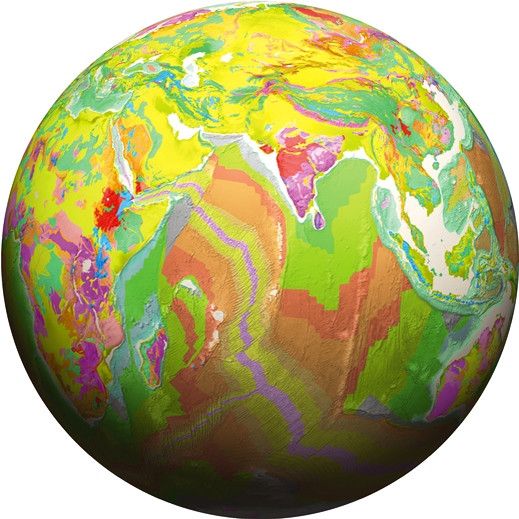 Joel C. Gill1,2 and Martin Smith1 ask why geology matters in the attainment of the UN’s sustainable development goals.
Joel C. Gill1,2 and Martin Smith1 ask why geology matters in the attainment of the UN’s sustainable development goals.
When future textbooks on global sustainable development are published, 2015–2030 will either be seen as a period of exciting and meaningful progress, or as a missed opportunity. Why? Because in 2015, the international community agreed three global development frameworks to tackle disaster risk reduction, sustainable development, and climate change.
Picture: Geology is essential to global development, and securing a sustainable future (Geological data derived from World CGMW 1:50M Geological Units Onshore, with the permission of OneGeology).
Meeting the ambitious targets and goals described within these frameworks to secure a sustainable future will require integrated approaches. Geoscience is one (of many) disciplines that are necessary if we are to support development priorities at local, regional and global scales.
Between 1990 and 2015, GDP per capita (in current US$) increased from $293 to $618 in low-income countries
1. Alongside this growth, there have been (on average) 130,000 people moving out of extreme poverty every day
2. This is a remarkable achievement, and when combined with continued trends in low-income countries for more people to have access to an improved water source and the decreasing prevalence of undernourishment1 we can take heart that humanity’s future may not be as depressing as some elements of the media suggest.
Positive
This positive story, however, is not uniform. In Tanzania, access to an improved water source has increased from 54% to 56% over 25-years, compared to an average in low-income countries of 47% to 66%
1. Ensuring we leave nobody behind, and existing development gains are not threatened, will require us to consider what a sustainable future looks like, and take the steps required to bring this to fruition.
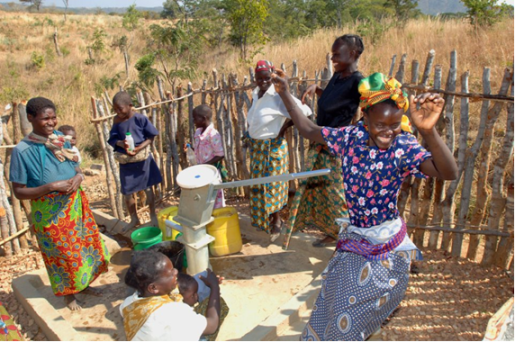 Picture:
Picture: As of 2015, 91% of the global population have access to clean drinking water
1 (Image Credit, Hudson Shiraku).
Sustainable development is widely defined as ‘development that meets the needs of the present without compromising the ability of future generations to meet their own needs’3. It is a multi-faceted concept that involves interlinked aspects of economic, social and environmental securities. In 2015, three global frameworks, encompassing different components of sustainable development, were agreed.
(i) Sendai Framework for Disaster Risk Reduction (SFDRR)4
The SFDRR was adopted at the 3rd UN World Conference on DRR in March 2015, supported by the United Nations Office for Disaster Risk Reduction (UNISDR). Through its implementation, the SFDRR aims to reduce substantially ‘disaster risk and losses in lives, livelihoods and health and in the economic, physical, social, cultural and environmental assets of persons, businesses, communities and countries’. The SFDRR has four priorities for action, including: understanding disaster risk; strengthening disaster risk governance to manage disaster risk; investing in disaster risk reduction for resilience; and enhancing disaster preparedness for effective response and to ‘Build Back Better’ in recovery, rehabilitation, and reconstruction. Underpinning the framework are 13 guiding principles (e.g., engagement from all of society; decision-making to be inclusive and risk-informed while using a multi-hazard approach).
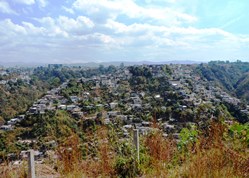 Picture:
Picture: Urban development on unstable slopes in Guatemala.
(ii) UN Sustainable Development Goals (SDGs)5.
In September 2015, member states of the United Nations formally adopted the SDGs. The SDGs are an ambitious set of 17 goals and 169 targets. They aim to eradicate global poverty, end unsustainable consumption patterns, and facilitate sustained and inclusive economic growth, social development, and environmental protection over a 15-year timeframe (2015-2030). Specific goals include achieving gender equality; ensuring availability and sustainable management of water and sanitation for all; and ensuring sustainable consumption and production patterns.
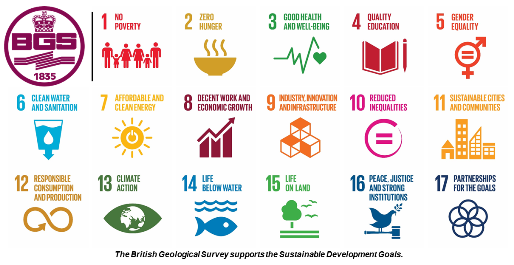
Left: The 17 Sustainable Development Goals, agreed by the United Nations in 2015 (SDG icons used in accordance with UN guidelines).
(iii) COP21 Paris Agreement on Climate Change (Paris Agreement)6.
The Paris Agreement, adopted at the 21st Conference of the Parties (COP21) in December 2015, aims to limit global warming to well below 2°C above pre-industrial levels, and to pursue efforts to limit the temperature increase to 1.5°C above pre-industrial levels. The Paris Agreement emphasises both mitigation and adaptation, with climate action also emphasised in the SDGs through Goal 13.
Picture: Children in Ladakh (India) express their concerns about the impacts of climate change.
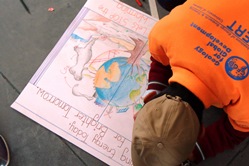
Sustainable development, expressed through the above frameworks, requires an integrated approach that links Earth and human systems. It requires understanding of lessons from the past, monitoring of the present, and modelling of potential future outcomes. Sustainable development is also spatially variant, requiring the ability to identify and understand development challenges at global, regional, national and local scales. Thus, a geoscientist’s integrated, multi-scale training and ability to think in 3D puts them in a strong position to contribute to a ‘framework for evaluating Earth’s sustained viability for life’7.
Integrated
Geoscientists not only have an ability to integrate data, and a way of thinking and working that can support sustainable development, but they are also in demand within many development strategies. For example, at a city scale Da Nang (Vietnam) published a resilience strategy in 2016 that demonstrates the importance of geoscience information in securing a sustainable, resilient future.
This strategy notes a desire to be a city with ‘infrastructure systems which can recover, and be well prepared for challenges in development process’, including planning ‘urban infrastructures and environmental services for climate change adaptation and mitigation’ and enhancing ‘inter-regional, multidisciplinary solutions in urban and environmental management (flood, drought and pollution)’
8. For this vision to be realised, we will need to integrate expertise from urban geoscience, groundwater, engineering geology, and geohazard communities with engineering, urban planning, and social science disciplines.
 Picture:
Picture: The urban landscape of Da Nang (Vietnam)
A role for geoscientists is also evident in national and regional (multi-country) level development strategies. For example, the national development plans for Saint Lucia, Montserrat and Saint Vincent and the Grenadines all emphasise improved disaster mitigation, indicating a role for geohazard specialists
9. Regionally, the East African Community (EAC) Vision to 2050 report identifies challenges of energy access, water and sanitation, food security, minerals development, environmental management, job creation, and urban development
10. The links with geoscience are immediately apparent, and the EAC themselves emphasise two principal enablers of their vision to be (i) science, technology, innovation, and (ii) improvements in research and development.
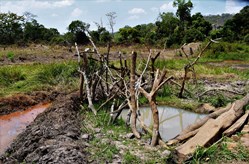 Picture:
Picture: Lack of access to clean, protected water sources remains a challenge for many communities in eastern Africa (Tanzania, 2014).
Global sustainable development frameworks (i.e., SFDRR, SDGs and Paris Agreement) also reflect a need for geological research and practice.
For example, the SFDRR Priority for Action ‘understanding disaster risk’ emphasises the need to understand all components of disaster risk, including ‘hazard’. Geoscience research on earthquakes, volcanic eruptions, tsunamis, landslides, floods, subsidence, and other natural hazards directly addresses this priority. In January 2016, the UNISDR hosted a Science and Technology Conference on the Implementation of the SFDRR, gathering scientists from multiple specialisms.
Geoscientists, including representatives from the British Geological Survey and Geology for Global Development, contributed to discussions such as the scope of science for DRR and mechanisms to accelerate the use of science and technology in DRR. One emerging research area, encouraged within the SFDRR, is the development of ‘multi-hazard’ approaches. Multiple, interacting natural hazards affect many regions, with a need for novel methods and tools to understand the impact of these interactions on lives and livelihoods.
.jpg?h=168&w=252&la=en) Picture:
Picture: Small pyroclastic density current generated at Soufrière Hills volcano (Montserrat). Photo Credit: G. Norton (1996) © NERC
Geoscientists also have a role in achieving the SDGs, either directly through our science or through our professional practice. For example, geoscientists have an essential role in the science required to ensure access to affordable, reliable, sustainable and modern energy for all (SDG 7), but will also need to review our educational and professional practices if we are to help achieve gender equality and empower all women and girls (SDG 5).
The matrix shows the 17 SDGs on the vertical axis and different aspects of geoscience on the horizontal axis. The matrix is populated by analysing text within the specific SDG sub-goals and targets, and is therefore likely to give a conservative perspective on the role of geoscience in sustainable development. Nevertheless, it demonstrates a role for the full spectra of geoscience sub-disciplines within the SDGs, with geoscience helping to deliver all 17 goals.
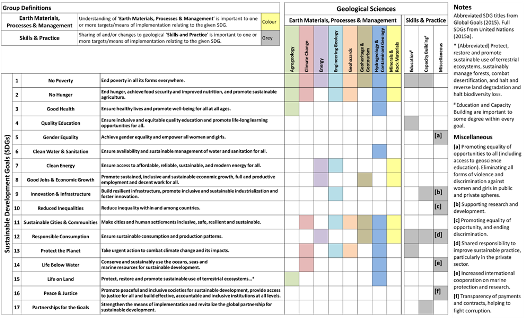 Table:
Table: A matrix highlighting the role of geologists in helping to achieve the SDGs
11. Please click on the image to see a larger version.
Finally, the Paris Agreement depends on access to the ‘best available science’, including geoscience. Our ability to constrain palaeoclimates, for example, is fundamental to interpreting future climate projections and understanding climate impacts on the environment, livelihoods, and geohazards. Reductions in carbon emissions will require green technologies, including geothermal, wind, and solar energy, as well as developments in carbon capture and storage.
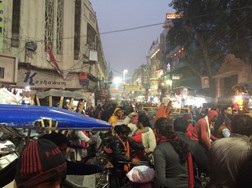 Picture:
Picture: Varanasi (India) is a key spiritual and tourist destination, placing pressure on essential development resources, such as energy and water.
Crucial
Geoscientists, therefore, will be playing a crucial role in the coming years if we are to ensure wide access to renewable energy. Greater demand for solar panels and wind turbines will result in an increased need for minerals such as cadmium, lithium, molybdenum, selenium, and tellurium, as well as rare earth elements (REE). The IUGS initiative ‘Resourcing Future Generations’ is one example of pro-active engagement by geoscientists, helping prepare for future changes in energy supply and demand. Innovative research, such as that being done by the interdisciplinary SoS RARE consortium is investigating how REE are concentrated in natural systems, with this information helping to determine more efficient and environmentally sensitive ways to recover REE
12.
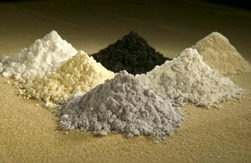 Picture:
Picture: Rare Earth Oxides, including praseodymium, cerium, lanthanum, neodymium, samarium, and gadolinium. (Image: Peggy Greb, USDA-ARS).
Responding
For our engagement to have greatest development impact, it will increasingly need to be as part of multi- and interdisciplinary platforms, working with disciplines such as social science, engineering, public health, and international relations. Our engagement should be underpinned by an improved understanding of good development practice, including listening and responding to the needs of those on the ground, co-designing research with stakeholders, understanding the role of indigenous knowledge, and building equitable research partnerships. Delivering the science that matters to people’s lives and livelihoods may require us to:
-
Consider how we train undergraduates, postgraduates and professionals;
- Attend meetings, publish in journals, and work with professionals from other disciplines; and
- Evaluate whether our working practices and outputs are fit-for-purpose for development work.
For example, undergraduates are rarely introduced to social-science research tools (e.g., semi-structured interviews), but these can be rich sources of data within many development-oriented projects. Interviews can help to understand challenges that people have at a local scale, appropriate technologies, and evidence of what has and has not worked before. Engaging in sustainable development is a great opportunity for the geoscience community, but comes with significant responsibilities also.
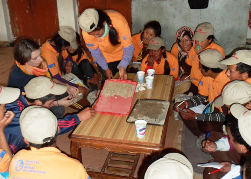 Picture:
Picture: Landslide education in Ladakh (India), requiring an understanding of cultural context.
The UK geoscience contribution to sustainable development will come through individuals in universities, businesses, public sector organisations and civil society. Here we outline examples of how two different groups will contribute to the SDGs, SFDRR and Paris Agreement over the coming years.
(i) British Geological Survey (BGS). The BGS have decades of international experience, working in partnership with diverse organisations to help countries apply science to their own development needs. From 2016–2020, BGS will increase the proportion of its research budget spent on Official Development Assistance (ODA), and will actively bid into Global Challenges Research Fund (GCRF) and Newton grant opportunities. This enhanced engagement in the development sphere, building on existing research strengths and experience, will support the delivery of the SDGs, SFDRR, and Paris Agreement. The BGS will work on three interlinked research platforms (RPs): integrated resource management in Eastern Africa (RP1), resilient Asian cities (RP2), and global geological risk (RP3).
In each RP, the BGS will work with overseas partners to understand their specific development needs, and then via workshops co-design and deliver research, informatics and outreach activities to address these. This work will likely extend across 13 countries and territories in eastern Africa (Ethiopia, Kenya, Malawi, Tanzania, Uganda, Zambia, Zimbabwe), Asia (India, Malaysia, Vietnam), and Latin America and the Caribbean (Montserrat, Saint Lucia, Saint Vincent and the Grenadines). Multiple approaches using concepts of resource corridors, catchments and citizen science will drive integrated science and a desired legacy of this work will be the nurturing of new multi-national, multi-disciplinary networks of researchers.
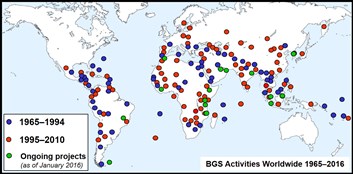 Picture:
Picture: BGS overseas engagement since 1965.
(ii) Geology for Global Development (GfGD). A registered charity, GfGD has championed the role of the SDGs since they were first agreed. Hosted by the Geological Society of London, GfGD convened one of the world’s first major gatherings to explore geoscience’s role in the SDGs in October 2015. They have since raised the profile of the SDGs and SFDRR through workshops at EGU and the 35th IGC, a further conference, and talks at multiple institutions around the UK and beyond. GfGD has recently published a 5-year strategy aimed at mobilising and equipping the geoscience community to engage with the SDGs, and working towards our long-term vision of seeing:
-
Every geologist equipped with the skills and understanding they need to make a positive contribution to sustainable development;
- A geology community actively engaged in the design, implementation, monitoring and evaluation of international development activities; and
- A world where organisations, governments and individuals have access to and an understanding of the geoscience required to ensure sustainable development.
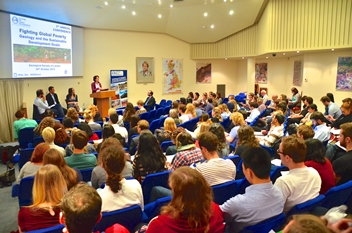 Picture:
Picture: Geology and the SDGs, hosted and supported by the Geological Society of London.
Conclusions
The global consensus, finance and policy changes that are necessary to deliver the SDGs, SFDRR and Paris Agreement are very ambitious. Success is dependent on many factors, not least the effective engagement of multiple communities of practice and fruitful interactions between them. The engagement of the geology community with the SDGs, and other disciplines engaged in sustainable development, is therefore essential. Geological research, monitoring, innovation and engineering can drive widespread improvements to wellbeing and quality of life. The SFDRR, SDGs and Paris Agreement provide a great opportunity for us to demonstrate to a global audience our desire to take a leading role in facilitating responsible Earth stewardship, for the public good and global development.
References
- http://data.worldbank.org/
- www.OurWorldInData.org
- Brundtland Commission (1987) Our common future, 383 p.
- UNISDR (2015) Sendai Framework for Disaster Risk Reduction.
- UN (2015) Transforming Our World: The 2030 Agenda for Sustainable Development.
- UNFCCC (2015) Paris Agreement on Climate Change.
- Stewart I., and Gill J.C. (2017) Social Geology - integrating sustainability concepts into Earth sciences, Proc. Geol. Assoc.,
- www.100resilientcities.org/strategies/city/da-nang
- www.caribank.org/countries/country-strategies
- www.eac.int/resources/documents/eac-vision-2050
- Adapted from Gill JC (2016) Geology and the Sustainable Development Goals, Episodes, 40(1)
- www.bgs.ac.uk/sosRare/home.html
Authors
1: British Geological Survey; 2: Geology for Global Development [Corresponding email:
[email protected]] Joel Gill is ODA Project Development Scientist at the British Geological Survey, and Founder/Director of Geology for Global Development. Martin Smith MBE is Science Director for Global Geoscience at the British Geological Survey.
Save